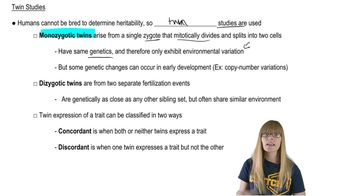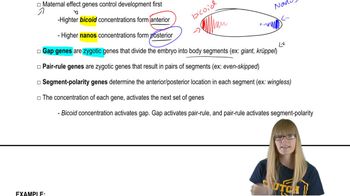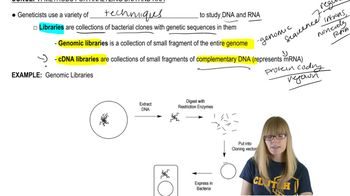Table of contents
- 1. Introduction to Genetics51m
- 2. Mendel's Laws of Inheritance3h 37m
- 3. Extensions to Mendelian Inheritance2h 41m
- 4. Genetic Mapping and Linkage2h 28m
- 5. Genetics of Bacteria and Viruses1h 21m
- 6. Chromosomal Variation1h 48m
- 7. DNA and Chromosome Structure56m
- 8. DNA Replication1h 10m
- 9. Mitosis and Meiosis1h 34m
- 10. Transcription1h 0m
- 11. Translation58m
- 12. Gene Regulation in Prokaryotes1h 19m
- 13. Gene Regulation in Eukaryotes44m
- 14. Genetic Control of Development44m
- 15. Genomes and Genomics1h 50m
- 16. Transposable Elements47m
- 17. Mutation, Repair, and Recombination1h 6m
- 18. Molecular Genetic Tools19m
- 19. Cancer Genetics29m
- 20. Quantitative Genetics1h 26m
- 21. Population Genetics50m
- 22. Evolutionary Genetics29m
18. Molecular Genetic Tools
Methods for Analyzing DNA
Problem 5b
Textbook Question
Explain the meaning of 'identity by descent' in the context of identifying genealogical relationship between individuals. In these analyses, why are segments of chromosomes (haplotypes) rather than individual STRs used to identify genetic relationships?
 Verified step by step guidance
Verified step by step guidance1
Understand that 'identity by descent' (IBD) refers to segments of DNA that are inherited from a common ancestor without recombination.
Recognize that IBD segments are used to identify genealogical relationships because they provide evidence of shared ancestry.
Consider that haplotypes, which are groups of genes inherited together from a single parent, are more informative than individual short tandem repeats (STRs) because they cover larger segments of the genome.
Acknowledge that using haplotypes allows for the detection of longer stretches of shared DNA, increasing the accuracy of identifying genetic relationships.
Realize that haplotypes can reveal more about the genetic history and relatedness of individuals, as they are less likely to be broken up by recombination compared to individual STRs.
Recommended similar problem, with video answer:
 Verified Solution
Verified SolutionThis video solution was recommended by our tutors as helpful for the problem above
Video duration:
3mPlay a video:
Was this helpful?
Key Concepts
Here are the essential concepts you must grasp in order to answer the question correctly.
Identity by Descent (IBD)
Identity by descent refers to the genetic relationship between individuals who inherit the same segment of DNA from a common ancestor. This concept is crucial in genealogical studies as it helps determine how closely related two individuals are based on shared genetic material. IBD segments can indicate familial connections and are essential for understanding inheritance patterns in populations.
Recommended video:
Guided course

Twin Studies
Haplotypes
A haplotype is a group of genes or DNA variations that are inherited together from a single parent. In genetic analyses, haplotypes are preferred over individual Short Tandem Repeats (STRs) because they provide a more comprehensive view of genetic relationships. By examining larger segments of chromosomes, researchers can better identify shared ancestry and the extent of genetic similarity between individuals.
Chromosomal Segments vs. STRs
Using segments of chromosomes, or haplotypes, rather than individual STRs allows for a more accurate assessment of genetic relationships. STRs can vary significantly among individuals and may not reflect shared ancestry effectively. In contrast, haplotypes encompass multiple genetic markers, providing a clearer picture of lineage and enhancing the reliability of genealogical analyses.
Recommended video:
Guided course

Segmentation Genes

 7:40m
7:40mWatch next
Master Methods for Analyzing DNA and RNA with a bite sized video explanation from Kylia Goodner
Start learningRelated Videos
Related Practice


